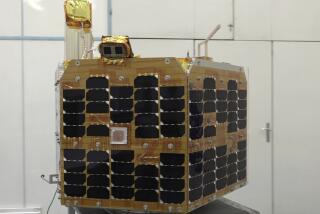After 16 Delays, Atlas Puts Weather Satellite Into Orbit : 2nd Successful American Space Shot in 2 Weeks
- Share via
VANDENBERG AIR FORCE BASE, Calif. — After 16 delays, a rebuilt 25-year-old Atlas rocket thundered into space today, carrying a $37.3-million weather satellite into polar orbit in a boost for the troubled space program.
It was America’s second successful space shot in two weeks. Before the successful launch of a Delta rocket from Cape Canaveral, Fla., on Sept. 5, the nation had suffered three failures in four orbital launchings, beginning with the Jan. 28 Challenger disaster.
The Atlas launch had been put off 16 times during the last year because of a series of administrative changes and technical troubles.
A crowd of 120 Air Force and National Aeronautics and Space Administration officials and contractors cheered as the 94-foot-tall Atlas E rocket, spewing bright orange flames into a thick gray cloud cover, blasted off at 8:52 a.m. from Space Launch Complex-3, carrying the RCA-built NOAA-G satellite into a 518-mile-high orbit.
“We have liftoff,” the flight commentator said as the rocket vanished into the clouds above the base 140 miles northwest of Los Angeles.
‘I Have Goose Bumps’
Placement in orbit was announced at 10:07 a.m.
“I have goose bumps, just like everyone else,” said Julie Andrews, spokeswoman for General Dynamics, which built the booster in 1961 as an intercontinental ballistic missile and refurbished it to launch the satellite.
In the first few minutes after launch, the nose cone covering the satellite and the five engines on the booster all separated from the spacecraft on schedule.
Upon attaining orbit, NOAA-G was renamed NOAA-10. It replaces the NOAA-6, launched in 1979, and joins NOAA-9, launched into polar orbit in December, 1984.
From its vantage point above Earth, the 14-by-6-foot satellite will photograph and collect global weather information, measure Earth’s radiation belts, relay data from weather stations worldwide to a central processing center, measure how much sunlight Earth absorbs and radiates back into space and detect distress signals from ships, planes and travelers in remote areas.
Reconnaissance Photos
It will also provide some reconnaissance photographs to U.S. intelligence agencies, said Larry Heacock, satellite operations director for the National Oceanic and Atmospheric Administration.
“It’s another step on the way back” from the explosion that destroyed Challenger and killed its seven crew members, NASA spokesman Jim Kukowski said. “Any successful launch is significant in showing the American public that we are coming back from a very disastrous eight months.”
More to Read
Sign up for Essential California
The most important California stories and recommendations in your inbox every morning.
You may occasionally receive promotional content from the Los Angeles Times.












